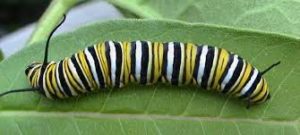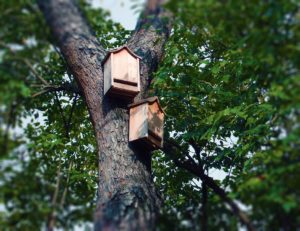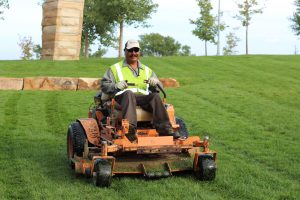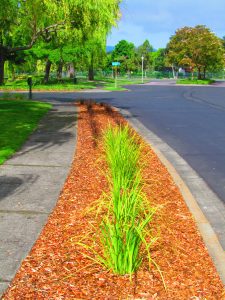
What is the value of the trees and shrubs on your property? What about the other plants and turf? No doubt there is not much room in your landscaping budget to spend thousands of dollars to replace dead or damaged plants and tree. That is why Terracare Associations has created our Landscape Preservation Program.
What is Landscape Preservation?
Landscape Preservation refers to the landscape care and health of important outdoor assets such as trees, shrubs, and turf on your commercial property. Replacing high dollar landscape assets can be avoided with ongoing, year-round TLC. A common way to refer to preserving your landscape assets is, Integrated Pest Management. According to the EPA (Environment Protection Agency) “Integrated Pest Management (IPM) is an effective and environmentally sensitive approach to pest management that relies on a combination of common-sense practices.”
Landscape Preservation and plant health care (PHC) use current, comprehensive information on the life cycles of pests and plants to create a fine-tuned program for your property. This program, in combination with available pest control methods, is used to keep your plants and trees healthy as well as manage pest damage with the least possible hazard to people, property, and the environment.
The Three Key Benefits of Landscape Preservation
The goal of Landscape Preservation is to keep your plants and trees healthy. We believe that healthy tree is a happy tree. The same goes for shrubs and other plants.
Healthy plants are better able to fight off insects, disease and other pests. By regularly inspecting plants and trees on your property, we are able to take the needed steps to keep your trees and plants healthy.
Proper feeding and watering throughout the year eliminates many pest problems. By strengthening and stabilizing the landscape, we can create the proper balance of conditions that are more favorable for plants than for pests.
At TCA, we often recommend this program to larger commercial properties, especially those who are concerned with LEED Certification and an eco-friendly approach to pest management.
- On large, commercial properties, where hand-pulling weeds is neither practical nor cost efficient.
- By monitoring, preventing and controlling damaging pests you can reduce your use of chemicals that can harm the environment and save money.
- Landscape Preservation gives you greater knowledge of pest activity on your property.
Creating a Customized Landscape Preservation Program
- Inspecting and Monitoring
A trained landscape professional will regularly monitor your property for signs of harmful pest infestation. While insects are a common problem, they are not the only problem that should be monitored. We watch for early signs of plant/tree diseases and weeds in turf areas and floral beds.
The sighting of a few insects does not necessarily pose a threat to the plants on your property. Keep in mind, not all insects require control. Many are not harmful, in fact, some are even beneficial. For instance, lady bugs eat aphids and certain wasp species that feed on web worms. These are just a few of the insects you should welcome.
Each Landscape Preservation Program is customized for a specific property. This is not a one size fits all program. We understand that plant care and pests control varies from region to region.
What is needed in North Texas can be different even in other parts of the state. The same is true in California, Utah, and Colorado, That is why we take a personalized view of each property. To fully understand the needs of your property, we may need to take soil samples or examine the water table.
2. Prevention
Implementing proper maintenance and plant care techniques will go a long way in preventing many of the pests common to your area.
Mowing turf areas at the highest setting for your grass type promotes deeper roots, preventing water loss. Taller grass also cools the soil and reduces heat stress in summer. Proper watering will ensure that the grass stays healthy. Frequent watering encourages shallow and weak root systems.
Performing a soil test to determine its pH levels will help prevent you from overusing fertilizer. Improper use of fertilizer promotes weed growth and makes plants more susceptible to disease.
3. Control
Landscape Preservation emphasizes non-chemical and biological methods of plant health and pest control. However, when chemical control is called for, it is important to choose the least toxic methods.
Various methods are used to control pest problems. Cultural control methods, such as mulching beds and other areas, help to control weeds. Mechanical control employs the use of devices, such as traps for rodents and insects.
Is your property ready for winter? Contact Terracare Associates to find out how you can protect and preservation the beauty and health of the plants on your property.
This is part 3 of a 3 part series on the benefits of winterizing and preserving your landscape:
Part 1: The Importance of Winterizing Your Landscape
Part 2: Why Your Property Need a Winter Watering Program
Part 3: Landscape Preservation: How Integrated Pest Management Can Save You Money
_____________________
Terracare Associates [TCA] is a recognized leader in outdoor maintenance in the Western United States – with 30 years of experience. During all seasons, our certified and experienced staff improves landscapes, parks, roadways and infrastructure for beautiful, safe and sustainable outdoor environments.
For more information about Integrated Pest Management:
 Use recycling practices
Use recycling practices







